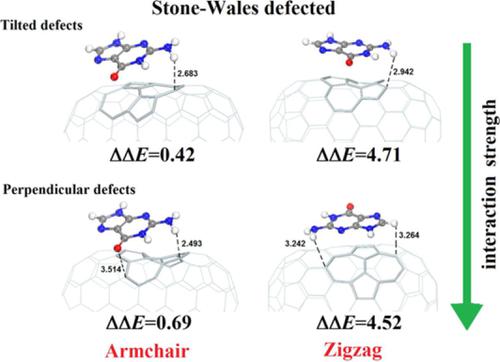当前位置:
X-MOL 学术
›
J. Comput. Chem.
›
论文详情
Our official English website, www.x-mol.net, welcomes your feedback! (Note: you will need to create a separate account there.)
A dispersion‐corrected density functional theory study of the noncovalent interactions between nucleobases and carbon nanotube models containing stone–wales defects
Journal of Computational Chemistry ( IF 3 ) Pub Date : 2019-12-14 , DOI: 10.1002/jcc.26127 Flavio F Contreras-Torres 1 , Elena V Basiuk 2 , Vladimir A Basiuk 3
Journal of Computational Chemistry ( IF 3 ) Pub Date : 2019-12-14 , DOI: 10.1002/jcc.26127 Flavio F Contreras-Torres 1 , Elena V Basiuk 2 , Vladimir A Basiuk 3
Affiliation

|
The noncovalent bonding between nucleobases (NBs) and Stone–Wales (SW) defect‐containing closed‐end single‐walled carbon nanotubes (SWNTs) was theoretically studied in the framework of density function theory using a dispersion‐corrected functional PBE‐G06/DNP. The models employed in this study were armchair nanotube (ANT) (5,5) and zigzag nanotube (ZNT) (10,0), which incorporated SW defects in different orientations. In one of them, the (7,7) junction is tilted with respect to SWNT axis (ANT‐t and ZNT‐t), whereas in ANT‐p and ZNT‐p models the (7,7) junction is parallel and perpendicular to the axis, respectively. The binding energies for uracil, thymine, cytosine, 5‐methylcytosine, adenine, and guanine interacting with the defect‐containing nanotube models were compared to the values previously obtained with the same calculation technique for the case of defect‐free SWNTs, both in the gas phase (vacuum) and in aqueous medium. For most models, the interaction strength tends to be higher for purine than for pyrimidine complexes, with a clear exception of the systems including ZNT‐p, both in vacuum and in aqueous medium. As it could be expected, the binding strength in the latter case is lower as compared to that in vacuum, roughly by 2–4 kcal/mol, due to the implicit inclusion of a medium (i.e., water) via the conductor‐like screening model model. The closest contacts between NBs and SWNT models, frontier orbital distribution, and highest‐occupied molecular orbital–lowest‐unoccupied molecular orbital gap energies are analyzed as well. © 2019 Wiley Periodicals, Inc.
中文翻译:

核碱基与含有斯通威尔斯缺陷的碳纳米管模型之间非共价相互作用的色散校正密度泛函理论研究
在密度函数理论的框架下,使用色散校正的功能 PBE-G06/DNP 对核碱基 (NBs) 和 Stone-Wales (SW) 缺陷的封闭端单壁碳纳米管 (SWNTs) 之间的非共价键进行了理论研究. 本研究中使用的模型是扶手椅纳米管 (ANT) (5,5) 和锯齿形纳米管 (ZNT) (10,0),它们包含不同方向的 SW 缺陷。在其中之一中,(7,7) 结相对于 SWNT 轴(ANT-t 和 ZNT-t)倾斜,而在 ANT-p 和 ZNT-p 模型中,(7,7)结是平行和垂直的分别到轴。尿嘧啶、胸腺嘧啶、胞嘧啶、5-甲基胞嘧啶、腺嘌呤、与含缺陷纳米管模型相互作用的鸟嘌呤与先前使用相同计算技术在气相(真空)和水性介质中无缺陷 SWNT 的情况下获得的值进行了比较。对于大多数模型,嘌呤的相互作用强度往往高于嘧啶复合物,但包括 ZNT-p 在内的系统明显例外,无论是在真空中还是在水性介质中。正如预期的那样,后一种情况的结合强度比真空中的低,大约低 2-4 kcal/mol,这是由于通过类似导体的屏蔽隐含了介质(即水)模型模型。还分析了 NBs 和 SWNT 模型之间的最密切接触、前沿轨道分布和最高占据分子轨道 - 最低未占据分子轨道间隙能量。
更新日期:2019-12-14
中文翻译:

核碱基与含有斯通威尔斯缺陷的碳纳米管模型之间非共价相互作用的色散校正密度泛函理论研究
在密度函数理论的框架下,使用色散校正的功能 PBE-G06/DNP 对核碱基 (NBs) 和 Stone-Wales (SW) 缺陷的封闭端单壁碳纳米管 (SWNTs) 之间的非共价键进行了理论研究. 本研究中使用的模型是扶手椅纳米管 (ANT) (5,5) 和锯齿形纳米管 (ZNT) (10,0),它们包含不同方向的 SW 缺陷。在其中之一中,(7,7) 结相对于 SWNT 轴(ANT-t 和 ZNT-t)倾斜,而在 ANT-p 和 ZNT-p 模型中,(7,7)结是平行和垂直的分别到轴。尿嘧啶、胸腺嘧啶、胞嘧啶、5-甲基胞嘧啶、腺嘌呤、与含缺陷纳米管模型相互作用的鸟嘌呤与先前使用相同计算技术在气相(真空)和水性介质中无缺陷 SWNT 的情况下获得的值进行了比较。对于大多数模型,嘌呤的相互作用强度往往高于嘧啶复合物,但包括 ZNT-p 在内的系统明显例外,无论是在真空中还是在水性介质中。正如预期的那样,后一种情况的结合强度比真空中的低,大约低 2-4 kcal/mol,这是由于通过类似导体的屏蔽隐含了介质(即水)模型模型。还分析了 NBs 和 SWNT 模型之间的最密切接触、前沿轨道分布和最高占据分子轨道 - 最低未占据分子轨道间隙能量。



























 京公网安备 11010802027423号
京公网安备 11010802027423号